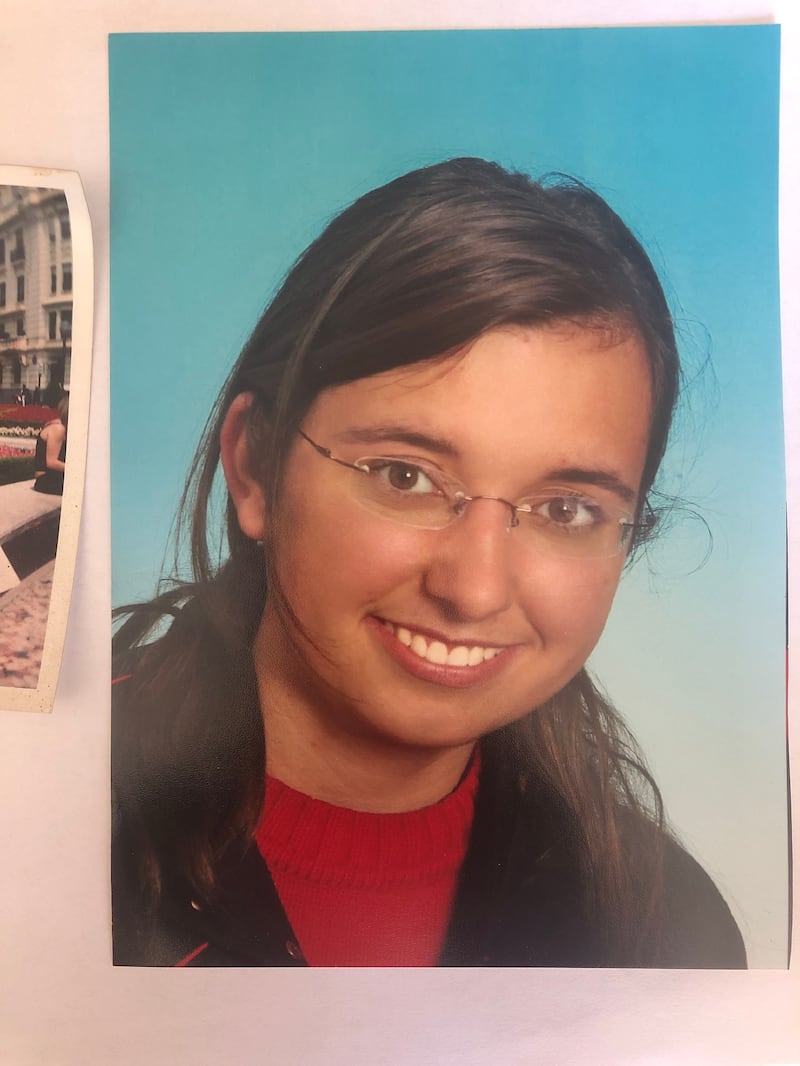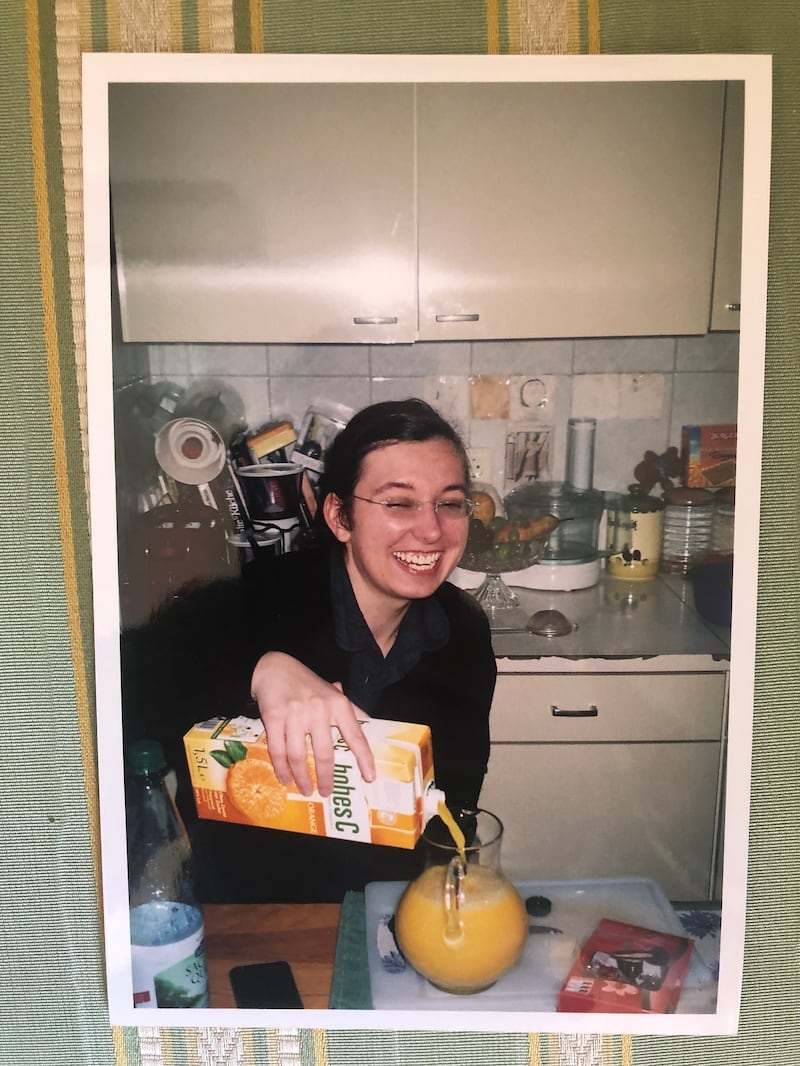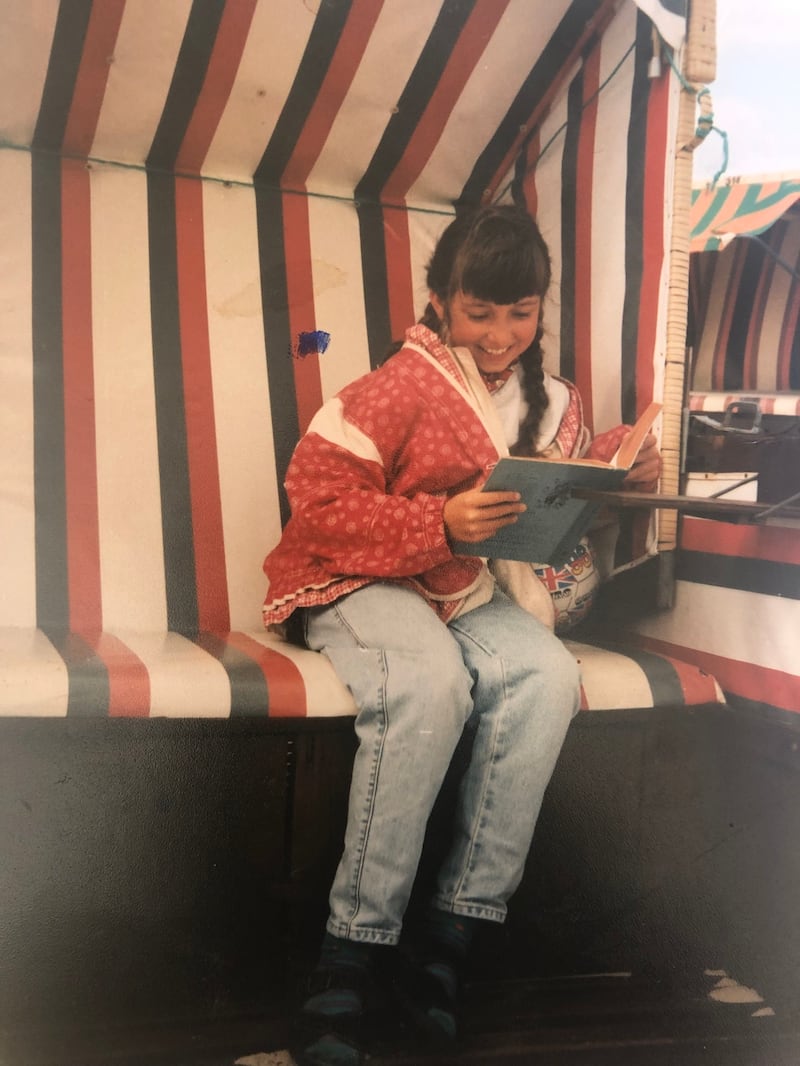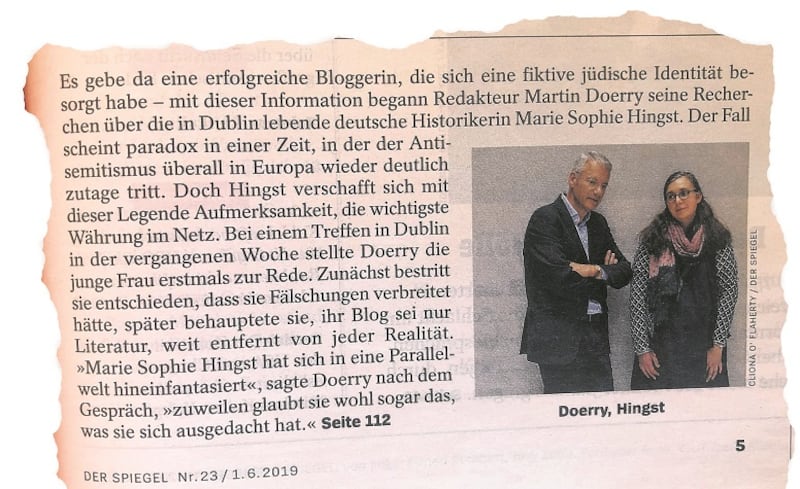I met Sophie Hingst for the first and last time almost seven weeks ago, on a balmy Sunday afternoon in Berlin.
Waiting at the train station opposite the glistening waters of the Wannsee Lake, she crept up behind me like a cat. She didn’t say hello and her brown eyes, owlish behind large round glasses, avoided my gaze. Her cheeks were flushed and her long hair, originally brown but going grey and ragged at the roots, was pulled back in a ponytail.
Murmuring to herself, she began walking on ahead of me. I followed, tried to make small talk and wondered where this was going. Now, I finally know.
For three hours that day we sat, walked and talked. The 31 year old told me about her childhood in eastern Germany, her studies in Berlin, Lyon, Los Angeles and Dublin, and her love of literature – in particular the literary master Heinrich von Kleist.
And she explained how, in the previous week, the new home she had made in Ireland had been turned upside down by an article in Germany’s Der Spiegel magazine.
“This is what comes about when you’re skinned alive,” she said, as we sat staring out at the gentle waves of the Havel river that flows into the Wannsee. “This is about a publishing house hanging someone out on a fence to dry.”
'Inventing Holocaust victims is essentially a mockery of all those who really were tortured and killed by the Nazis'
The real story is not that simple. Nine days previously, on May 31st, I received advance notice that Der Spiegel was running a report the following day on a blogger and history doctoral graduate of Trinity College Dublin (TCD). The magazine claimed Sophie had invented 22 Holocaust victims, many in her family, and had lodged documents memorialising them with Israel’s Holocaust memorial, Yad Vashem.
Der Spiegel journalist Martin Doerry, whom I'd met once before briefly, explained to me on the phone his weeks of work picking apart her blog, Read On, my Dear, Read On.
In the blog, mostly reportage with literary ambitions, a figure Sophie called “Fräulein Read On” wrote about her life in Ireland and in Germany, but also about her Jewish identity and family.
A regular figure was her beloved grandmother, an Auschwitz survivor who held annual parties for other elderly survivors. Every year on November 9th, she wrote how her grandparents remembered Kristallnacht – the 1938 Nazi-organised pogrom against Jews. They would stop the clocks and sit in the growing darkness, she wrote, waiting for relatives who never returned.
When researchers, and later readers, challenged her on apparent inaccuracies and problematic details in her blog, Sophie attacked them and dismissed their queries, in one case, as “outrageous slander”. Last December a researcher contacted Der Spiegel and, slowly, a complicated story began to emerge.
‘A mockery’
Starting in September 2013 Sophie sent to Israel’s Yad Vashem memorial 22 “pages of testimony” forms, most filled in by hand, detailing people lost to the Holocaust. Most people in the forms had Jewish-sounding names – Cohen, Rosenwasser, Zilberlicht – but most had no record of ever existing.
Combining the Yad Vashem documents with Sophie’s own blog writings, Doerry stitched together her conflicting, contradictory narrative and flawed family tree. While she claimed many relatives were murdered in Auschwitz and only a handful survived, none were noted in any civil or Holocaust records. And the handful who existed were not Jewish, as she claimed, but Lutheran.
“This kind of con job may not be a crime per se but it is nevertheless scandalous,” wrote Doerry in Der Spiegel. “Inventing Holocaust victims is essentially a mockery of all those who really were tortured and killed by the Nazis.”
'My daughter has many realities and I only have access to one,' Sophie's mother said, and told of her daughter's years of struggle with mental illness, repeated attempts at therapy
That was exactly how Tomi Reichental felt when I called him in Dublin for comment for my own report the day before the Spiegel story was published. Originally from Czechoslovakia, he survived Bergen-Belsen camp but lost many family members. He has dedicated his later years in his adoptive home to visiting schools as a living witness to Holocaust horrors.
“People like myself are genuine but this does damage to us,” he told me that Friday afternoon, the last day of May, “because people immediately begin to think, ‘Is he telling the truth?’”
As I worked on my news story that afternoon, I noticed the blog was quickly vanishing offline. I saved what I could and contacted Sophie by email seeking comment. Her one-line reply: “I deny all accusations made by the Spiegel and will seek for [sic] legal clarification on that matter.”
Late that evening The Irish Times chose not to run my news piece and I emailed her again suggesting we meet instead.
Even though we held back the story, it was soon doing the rounds in Dublin. The website of Russian propaganda broadcaster RT had run a piece and TCD student publications had gotten hold of the story. Finally, Der Spiegel translated its entire article into English and made it available on its website.
Inconsistencies
Days later, as we sat on a dusty river bank, she said her life as she knew it had evaporated in the previous six days.
With an accusing gaze, she challenged me to ask her questions. Instead I said nothing, hoping my silence would let her talk.
She told me about her mother, Rachel, a “madwoman” from a French-Israeli family in the Languedoc region who worked with Médecins Sans Frontières (MSF). Together they travelled the world until Sophie was 16.
“Then I found my mother in the bath with a bullet in her head,” she said. “My mother took her own life.”
Her father remarried, she said, and she grew up close to her paternal grandmother Helga Brandl. She was a Lutheran dentist but Sophie insisted she was an Auschwitz survivor with a number tattooed on her arm.
What was the number, I asked.
She hesitated before answering: 6140.
Without warning, from her pocket, she produced a leatherette wallet, unzipped it and took out something that she pressed into my hand. I unfolded a yellow cloth star with “Jude” written in the centre: one of the yellow stars all Jews were forced to wear under the Nuremberg Laws.
“This star and a smashed pair of glasses were all [my grandmother] had after Auschwitz,” she said in a low voice. “Touch it and please ask me again if I’m staging things. This is what you’re doing to me, forcing me to say this.”
I could sense her looking at me, waiting for a reaction. I thought first of the Holocaust, then I thought of Ebay. But I kept my expression neutral as I handed it back.

Soon she was describing her confrontation with Doerry of Der Spiegel three weeks previously. They met in Dublin’s Merrion Hotel to talk about an art book she had written. Doerry flagged ahead of time he would be asking her questions about her blog and her Jewish family, but she insisted this was out of bounds.
At their meeting he pressed ahead anyway, she said, and presented her with five pages querying details and flagging inconsistencies in her blog. She stormed out of the interview after an hour.
“He wrapped it up as a kind of a detective story... it’s so juicy and he does it so well,” she told me. “He talked to me like a bounty hunter, he didn’t have any questions... he just came to present an overview of the results. It was like a kind of TV series where the guilty party is presented with the documents against them.”
She described feeling cornered by Der Spiegel: forced after its article to prove herself a German Jew – in the third generation after Auschwitz – by unearthing her grandmother’s Nazi-era star.
In the next breath, she denied having filed the Yad Vashem documents about her lost Holocaust relatives, although they are in her handwriting and she put images of them up on her own Twitter feed. She also claimed someone was impersonating her, that she had taken on a lawyer and had filed a complaint with the police.
‘Many realities’
As two hours turned into three, I found myself listening less to the detail of her story and instead watching her body language and other signals. Her voice went from playful girl to angry adult and back again, punctuated by random laughs. Her face flushed, then went pale. Her hands fluttered around in her lap like two restless birds.
When our walk ended, I had nothing more to say, realising I was out of my depth. This was no news story. This was a very agitated woman who needed help – and, knowing we were parting company soon, I was afraid that I might be the last person to see her alive.
As we parted, I repeated some sentences a therapist friend had given me. I said I wasn’t sure what had happened, what the real story was, but I hoped that she had someone to talk to about this and someone to spend time with this evening: a friend or her family. She said she did and walked off.

Later I made two phone calls. First to Cornelia Hingst, listed in the German phone book as a dentist in Wittenberg. When I asked about Rachel Hingst, Sophie’s Jewish mother, she sighed audibly down the phone. There was no Rachel. She, Cornelia, was her birth mother and not, as Sophie said, her stepmother.
“My daughter has many realities and I only have access to one,” she said. She told of her daughter’s years of struggle with mental illness, repeated attempts at therapy and a new stability she found in Ireland.
Cornelia was worried that the revelations would go down badly with Sophie’s employer in Ireland, chip company Intel, and that losing her job might destabilise her further. I urged her to contact her daughter and, in her agitated state, to not leave her alone.
Then I contacted Rabbi Zalman Lent in Dublin. He had heard rumours of the story but said he had never met Sophie, nor did he recognise her from services.
“It’s a small community, so I would know her if she had been here,” he said.
'I only ever am a greedy thief, full of hunger for words. And, as you and the world at large can see, it didn't end well'
Contact with Yad Vashem yielded a written statement saying that 4.8 million names of Holocaust victims are on record with the Jerusalem institution.
Documents such as those submitted by Sophie “undergo a brief vetting process to verify basic details” but “the process is not foolproof and we have, at times, been alerted to faulty information included”.
“We accept that the pages of testimony are submitted in good faith, and request the signature of the submitter who is ultimately responsible for the information therein,” the statement added. “The submissions of Marie Sophie Hingst have been given to Yad Vashem scholars for further investigation.”
Another trauma
I had already sought out two friends, one a therapist and the other a medical doctor.
Though wary of offering a long-distance diagnosis they agreed, independently of each other, that Sophie appeared – from her confused story but also her physical signals – to have a psychological disturbance.
Such disturbances were eminently treatable, the therapist friend said, adding that Germans claiming to be from Jewish families touched by the Holocaust was not an unusual phenomenon. The need to be associated with the victims rather than the perpetrators in such a context was, he said, often linked to another trauma in a person’s life.

Five days after meeting Sophie, I travelled to Hamburg to meet Doerry, author of the Spiegel article. Walking from the main station to the magazine’s glass complex, I called Reichental again.
I described to him the agitated woman I met and explained to him Sophie’s apparent mental health issues. I had decided that, given this, it was not a story for The Irish Times. Would he be alright with that?
“Of course,” he said. “The poor girl needs help. Publishing would only cause more pain.”
A few minutes later, in the atrium cafe of Der Spiegel’s Hamburg headquarters, Doerry explained his reasons for going ahead with the story.
Last October Doerry had a similar case of a man who had set himself up as head of a Jewish community near Hamburg despite being a German Protestant. Doerry is also the grandson of a Holocaust victim. And, last December, Der Spiegel admitted that a star journalist had “falsified ... articles on a grand scale”
In at least 14 compelling features, 33-year-old Claas Reloitius invented characters, places and encounters. The full scale of the fraud plunged the magazine into one of its greatest crises in its 72-year history.
Doerry, a historian and the magazine’s former deputy editor, was anxious to stop Sophie because her lies were becoming more outlandish. She had won a 2017 blogger of the year award for her online writings and, in 2018 in Dublin, accepted a young writers’ prize from the Financial Times with a speech mentioning her “Jewish” family.
Cornelia called me to say the police had been in touch. Her daughter was found dead in her bed in Dublin the day before
Previous attempts to challenge her had fallen flat. So the approach in Dublin was to confront her with the facts.
Cornelia, Sophie Hingst's mother, phoned me a few times about her daughter's progress: Intel, her Irish employer had agreed to keep her on, provided she attend sessions with an in-house therapist. Her daughter had begun to see she needed assistance, she said, but was haunted by her online reputation. A Wikipedia entry was created in her name, describing her as a "blogger and fraudster". Der Spiegel's report remains online in German and in English, the latter available for free.
In Wittenberg, Cornelia said she was looking forward to a new life after retiring from her dentist practice.
Last week, while on holidays on Germany’s Baltic Coast, Cornelia called me to say the police had been in touch. Her daughter was found dead in her bed in Dublin the day before, Wednesday July 17th. Cornelia immediately thought her daughter had taken her life. Autopsy results have yet to confirm this; police say there is no sign of third-party involvement.
‘Many pieces’
As I listened to the mother’s voice, choked with confusion and grief, my mind flashed back to the woman I met almost seven weeks ago: agitated and wounded, yet intelligent and even humorous. A troubled soul and a talented writer, but also someone who – weeks beforehand – attacked Doerry for challenging her falsehoods about having Holocaust survivor and victim ancestors.
Before the article appeared, and pressed by her mother, Sophie called Doerry to apologise. She admitted making mistakes but insisted she was only repeating what she had learned from her mother. In Der Spiegel Doerry suggested she was “now trying to scapegoat her deceased Protestant grandmother”.
Before the article appeared Sophie had engaged a lawyer, insisting her writings were of a literary nature, and a statement to that effect appeared on the blog.

In hindsight it appears each side – the Hingsts and Doerry – felt the other side was acting aggressively. Cornelia accuses Doerry of failing to see the person behind the facts.
After her death Doerry commented at length to The Irish Times but refused to allow his remarks be published. Instead he dictated a one-line statement: “Der Spiegel will not comment on the article and regrets the death.”
Back in Germany, critics of the Hingst family accuse them of shirking their responsibility to intervene and prevent Sophie spreading Holocaust lies, as well as other articles claiming she founded a sex education clinic in a New Delhi slum.
Cornelia insists she was unaware of the scale of her daughter’s deception, that she had filed documents with Yad Vashem or that her daughter’s online writings had now seeped into her daily life and public persona.
“When I asked Sophie once about this she said she was not whole,” says Cornelia, “and that she had very many pieces.”
Both Cornelia and Doerry were dealing with a complex, troubled person whose many facets were never visible at once to them.
The tragedy of the story is that Sophie, the only person who could explain her motivations and her pieces, is now dead. She will be buried in her hometown of Wittenberg on July 31st.
‘Hunger for words’
Cornelia described as “exemplary” Intel’s treatment of their daughter, allowing her to stay on provided she saw a therapist. “The Irish are the only ones standing by us,” she said.
News of Sophie’s death came as a huge shock to her friends and former colleagues in Trinity College and in Intel. Former TCD colleagues are mourning a talented and kind person who did charity work for the Irish Red Cross.

At the start of our walk last month, Sophie insisted we visit a leafy glade and the grave where German literary genius Heinrich von Kleist shot his girlfriend and then himself in November 1811. The writer was just 34 when he died. Sophie was three years younger.
The original inscription, removed by the Nazis because it was from a Jewish writer, has been restored. We stood side by side, studying the words:
“He lived, and sang and suffered/in a cheerless, heavy time/here he sought death/and found immortality.”
Most of Sophie’s writing was lost with her vanished blog. Reading through our email correspondence reveals a woman who loved words – even if they sometimes betrayed her grip on reality.
“I am slightly jealous of all people who knew what they wanted to do, who knew words belong to them,” she wrote. “I only ever am a greedy thief, full of hunger for words. And, as you and the world at large can see, it didn’t end well.”

















